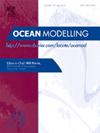Challenges in improving Arctic freshwater simulations: An evaluation of CMIP6 models in the Beaufort Gyre region
IF 2.9
3区 地球科学
Q2 METEOROLOGY & ATMOSPHERIC SCIENCES
引用次数: 0
Abstract
The performance of CMIP6 models in simulating freshwater content (FWC) in the Beaufort Gyre remains unclear. This study evaluated 17 CMIP6 models using both observational and reanalysis datasets. Additionally, a global ice-ocean coupled model based on Finite Volume Community Ocean Model (Global-FVCOM) was incorporated for reference. The results revealed a significant inter-model spread among the CMIP6 models in spatiotemporal variations of FWC, with discrepancies relative to the evaluation data that were larger than those exhibited in Global-FVCOM. These discrepancies were primarily attributed to simulation errors of the salinity structure within the CMIP6 models. Over half of the models indicated that the primary source of FWC error originated from the layers above the base of halocline, where most models underestimated FWC, while others suggested the error originated from the layers between the base of the halocline and the 34.8 psu isohaline, where models tended to overestimate FWC. Based on an overall evaluation using observational and reanalysis datasets, EC-Earth3, MRI-ESM2-0, and FIO-ESM-2-0 showed better performance relative to other CMIP6 models. However, these three models, along with the multi-model mean, exhibited larger errors than Global-FVCOM, suggesting that current CMIP6 models still face challenges in FWC simulation relative to some ice-ocean coupled models. The main aspects contributing to the errors, including discrepancies in uncertainties induced by internal variability, numerical configurations, vertical mixing schemes, model resolutions, freshwater inputs, and atmospheric forcings were further discussed in this study. This study enhances understandings of CMIP6 models’ capabilities to simulate FWC in the Beaufort Gyre region, providing valuable insights for future model improvements.
改善北极淡水模拟的挑战:波弗特环流地区CMIP6模式的评估
CMIP6模式在模拟波弗特环流淡水含量(FWC)方面的性能尚不清楚。本研究使用观测和再分析数据集评估了17个CMIP6模型。此外,还引入了基于有限体积群落海洋模型(global - fvcom)的全球冰海耦合模型,以供参考。结果表明,CMIP6模型在FWC时空变化上存在显著的模型间差异,与评估数据的差异大于Global-FVCOM。这些差异主要归因于CMIP6模式中盐度结构的模拟误差。超过一半的模型表明,FWC误差的主要来源是盐斜基底以上的层,其中大多数模型低估了FWC,而另一些模型则认为误差来自盐斜基底与34.8 psu等盐线之间的层,模型倾向于高估FWC。基于观测和再分析数据集的综合评价,EC-Earth3、MRI-ESM2-0和fi - esm2 -2-0相对于其他CMIP6模型表现出更好的性能。然而,这三种模式以及多模式平均值的误差都大于Global-FVCOM,这表明目前的CMIP6模式在FWC模拟中相对于一些冰海耦合模式仍面临挑战。本研究进一步讨论了造成误差的主要方面,包括由内部变率、数值配置、垂直混合方案、模式分辨率、淡水输入和大气强迫引起的不确定性差异。本研究增强了对CMIP6模型在波弗特环流地区模拟FWC能力的理解,为未来模型的改进提供了有价值的见解。
本文章由计算机程序翻译,如有差异,请以英文原文为准。
求助全文
约1分钟内获得全文
求助全文
来源期刊

Ocean Modelling
地学-海洋学
CiteScore
5.50
自引率
9.40%
发文量
86
审稿时长
19.6 weeks
期刊介绍:
The main objective of Ocean Modelling is to provide rapid communication between those interested in ocean modelling, whether through direct observation, or through analytical, numerical or laboratory models, and including interactions between physical and biogeochemical or biological phenomena. Because of the intimate links between ocean and atmosphere, involvement of scientists interested in influences of either medium on the other is welcome. The journal has a wide scope and includes ocean-atmosphere interaction in various forms as well as pure ocean results. In addition to primary peer-reviewed papers, the journal provides review papers, preliminary communications, and discussions.
 求助内容:
求助内容: 应助结果提醒方式:
应助结果提醒方式:


